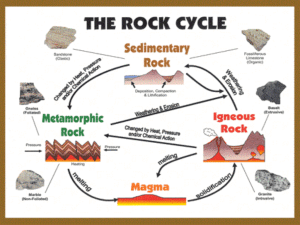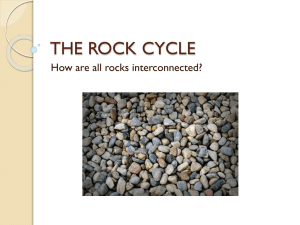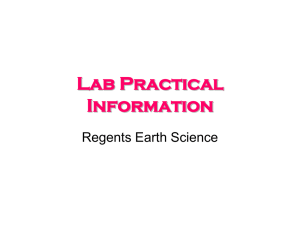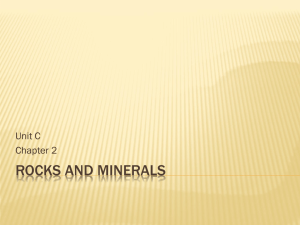Metamorphic rocks
advertisement
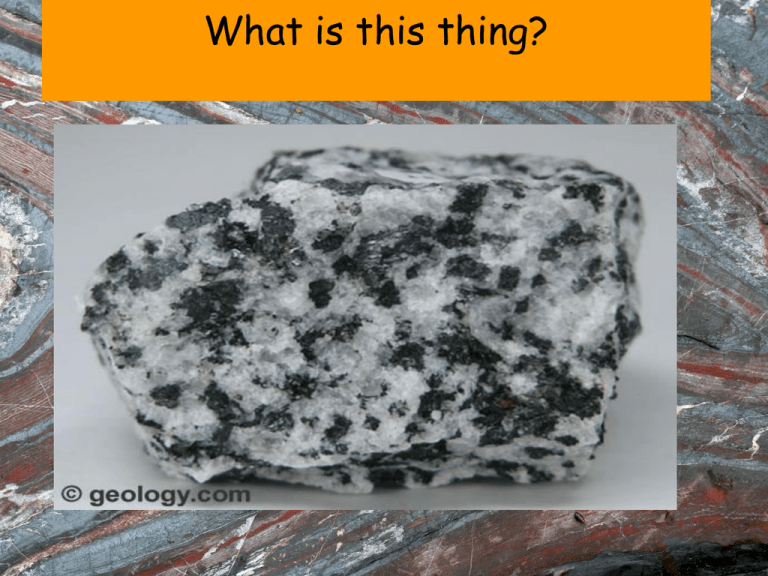
What is this thing? Essential Learning: I can explain what a rock is. Tell me what you know and what you want to know about rocks!!! Come up with at least 5 things!!! W K L What you What you What you want to Know. Know. Learned. Cannot fill in yet. Essential Learning: I can explain what a rock is. p. 75-80 Rock- is a naturally formed solid that is usually made up of one or more types of minerals. Three types of rocks: 1. Igneous 2. Sedimentary 3. Metamorphic Essential Learning: I can identify the three different types of rocks. Igneous rocks: forms when molten rock (magma/lava) cools and becomes solid. Sedimentary rocks: forms when pieces of older rocks, plants, and other loose materials get pressed or cemented together. Metamorphic rocks: formed when heat or pressure causes older rocks to change into new types of rocks. Rock Cycle: is the set of natural process that form, change, break down, and re-form rocks. “What’s a Rock?” Essential Learning: I can identify the three different types of rocks. Goto your lab table. In each of the tubs, try to identify the rock type: Do this for samples 1-7. Write this in your notebook 1. Write the name down of the sample. 2. Do you see crystals or no crystals? 3. Do you see sediment, large or small or no sediment? 4. Do you see fossils? 5. Do you see bands or lines in the sample? Different colors? 6. Do you think it is Igneous, Sedimentary or Metamorphic? Why do you think this? Essential Learning: I can explain the rock cycle. Igneous Rock Cycle Blue rocks Sedimentary rocks Metamorphic rocks Red Sediment Weathering/erosion Green Compaction/cementation Magma Melting yellow Cooling/crystallizing purple Heat and pressure Essential Learning: I can explain how the rock cycle works and how it has no end. P. 75-80 Essential Learning: I can identify different rock types. On page 80 answer questions 1-6. Put these in your notebook. You need to finish during class. Focus and get it done. 1. How are rocks and minerals different? 2. What are the three types of rocks? 3. Which rock types are most common within Earth’s crust? Which type is most common at Earth’s surface? 4. Why is the set of natural processes by which rocks change into other types of rocks called a cycle? 5. Which type of rock would you expect to be common on the floor of a large, deep lake? Why? 6. Draw a diagram showing how an igneous rock could change into a metamorphic rock and how a metamorphic rock could change into a sedimentary rock. Essential Learning: I can explain how the rock cycle works and how it has no end. Crayon Lab Igneous rocks Sedimentary rocks Use all of the terms all of these terms in summary. Explain how your crayon changed from one rock type to another and how the rock cycle can and will continue forever and ever and ever and ever and ever. Metamorphic rocks Sediment Weathering/erosion Compaction/cementation Magma Melting Cooling/crystallizing Heat and pressure Essential Learning: I can explain how IGNEOUS rocks form. p. 82-87 IGNEOUS ROCK (Latin) “From Fire” Igneous rocks: forms when molten rock cools and becomes solid. (solidifies) Form from Magma or Lava. Essential Learning: I can explain how igneous, sedimentary, and metamorphic rocks are formed. Texture of Igneous rock… Intrusive Igneous rock -Forms when magma cools within earth. -High temp allows magma to cool slowly. -Slow cooling allows time for LARGE mineral crystals to form. -Examples: Granite, Diorite, Gabbro Extrusive Igneous Rock -Forms when lava cools on earths surface. -The lower temp cause the lava to cool quick. -No time for mineral crystals to form. -Examples: Rhyolite, Pumice, Basalt, Obsidian Which picture intrusive and extrusive rock? How do you know? How could this be? Essential Learning: I can explain how igneous, sedimentary, and metamorphic rocks are formed. Intrusive Granite P. 84 Extrusive Basalt Essential Learning: I can explain how igneous, sedimentary, and metamorphic rocks are formed. Composition of Igneous Rock SILICA- a compound of silicon and oxygen. SiO2 Felsic Magma - Thick magma, high in SILICA. -Contains very little calcium, iron or magnesium. -Typically LIGHTER in color and less dense. Mafic Magma - Thin magma, low in SILICA. -Contains lots of iron, calcium and magnesium. -Typically DARKER in color and denser. p. 85 Essential Learning: I can explain how igneous, sedimentary, and metamorphic rocks are formed. Igneous Rock Lab. 1. Name 2. Intrusive or Extrusive. 3. Texture: Glassy, Fine, Coarse or Very Coarse 4. Color: Light or Dark 5. Silica rich or Silica poor 6. Felsic or Mafic 7. Minerals found in it. Follow the lines down Do this for all 7 samples. Please and thank you. Essential Learning: I can explain how Sedimentary Rocks form from earlier rocks, minerals, animal and plant matter. p. 89-95 Sedimentary Rock- rocks that form when sediments become pressed or cemented together or when sediments precipitate out of solution. Sediments- Materials that settle out of water or air. These can be loose pieces of rock, minerals, plant and animal remains. How do they form? p. 90 From rock particles cementing together: - Gravel, Sand, Silt/Clay Examples: -Sandstone, Conglomerate, Shale • Four common steps in this formation: 1.WEATHERING AND EROSION: Break it apart. 2.TRANSPORTATION: Move it along. 3.DEPOSITION: Stop moving man. 4.COMPACTION AND CEMENTATION: Squeeze and glue it. • From plants or shells cementing together: p. 92 Examples: -Coal, Limestone. FOSSILS found in these commonly. Fossils of DEAD things. COOL MAN. • Dissolved minerals re-form from water. p. 93 -Minerals that crystallized as water dried up. Examples: Chemical Limestone, dolostone, rock salt MONO LAKE, CA Sedimentary rocks show the action of wind and water. They tell us the story about past environments. Example: Cross Beds- Wind or water movement. Ripple Marks- Water movement commonly. Mud Cracks- Dried up lake bed. Essential Learning: I can explain how igneous, sedimentary, and metamorphic rocks are formed. Sedimentary Rock Lab. 1. Name 2. Texture: Clastic, Crystalline, Bioclastic 3. Grain Size... 4. Composition category... 5. Comments category... 6. Fossils? Describe if present. 7. How do you think if formed? Compaction Cementation, water solution, evaporation 8. Other observations? Do this for all 7 samples. Please and thank you. Essential Learning: I can explain metamorphic rocks are created. Metamorphic Rock p.96 Metamorphism- Process by which existing rock is changed by heat/pressure or both! The beginning rock can be: -Igneous -Sedimentary -Metamorphic Essential Learning: I can explain metamorphic rocks are created. p.98-99 Recrystallization- Pressure and heat breaking atoms bonds and minerals recrystallize. Metamorphic changes occur in different areas. • Contact MetamorphismSmall areas. - Cause Magma • Regional Metamorphism- Large areas. -Cause Plate Essential Learning: I can explain metamorphic rocks are created. Metamorphic Rocks develop bands of minerals. p. 100 Foliation- arrangement of minerals in flat or wavy bands. Foliated Rocks: when mineral grains line-up in parallel bands it is said that it has a "foliated texture". Examples: slate, phyllite, schist and gneiss Essential Learning: I can explain metamorphic rocks are created. Non-Foliated Metamorphic Rocks: a metamorphic rock where no banding occurred. The grains change, grow, and rearrange but don’t form bands. Examples: quartzite, marble (Sandstone = quartzite) (Limestone = marble) IF you were walking down the streets of Shakopee and you came across these rocks, what could you tell a stranger about them? How did they form? Use foliated and nonfoliated in your response. One is a gneiss and on is a quartzite. Essential Learning: I can explain metamorphic rocks are created. Essential Learning: I can explain metamorphic rocks are created. Metamorphic Rock Lab. 1. Name 2. Texture: Foliated (mineral alignment or Banding) or Nonfoliated 3. Grain Size: Fine, Fine to Medium, Medium to Coarse or Coarse 4. Composition category… 5. Type of Metamorphism: Regional or Contact 6. Comments category... 7. Other observations? Do this for all 7 samples. Please and thank you.


